
Audubon Adventures
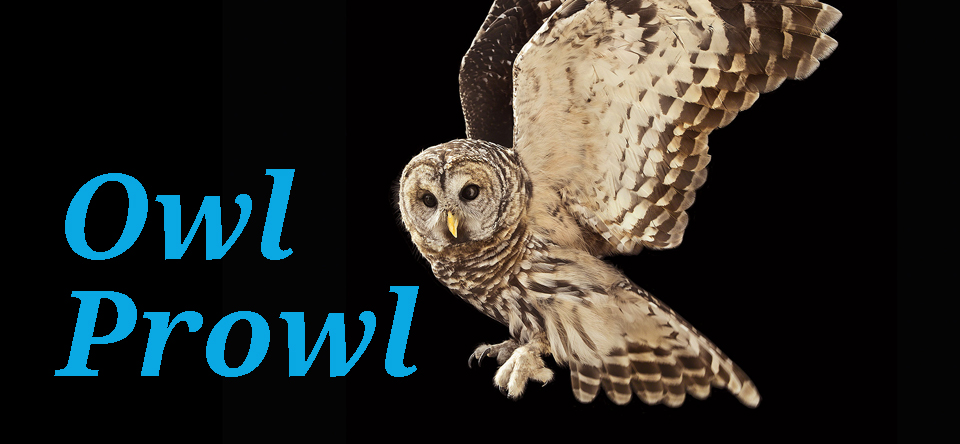
Background for Teachers
Owls can be found throughout the globe except in Antarctica and some South Pacific islands. Worldwide there are more than 200 species of owls. They frequent a great diversity of habitats, from the Arctic tundra to deserts to tropical forests.
Owls stand out among birds because of what many people consider to be humanlike characteristics: their large eyes that look straight out of a facial disc, the tufts of feathers that look like ears, their deep voices. Throughout human history owls have held a special place in our traditions, folklore, and myths, including being endowed with great wisdom and even magical powers.
The Eyes Have It
 Owls are birds of the hunt—predators. They are equipped with exceptional vision and excellent hearing in order to home in on prey. An owl’s eyes are probably it’s most distinctive feature. These organs are proportionately quite large and capable of rapid and sharp focusing at various distances. In fact some large species, such as the Great Horned Owl, have eyes larger than those of humans. Equally important, the eyes are directed forward and, since their fields of view greatly overlap, they provide excellent binocular vision. But because owls’ eyes are fixed in bony sockets, owls must turn their heads to see objects to the side. Extra neck vertebrae provide such great flexibility that an owl can turn its head through an arc of 270 degrees. Humans also have binocular vision, but our heads can only rotate 180 degrees. (But of course human eyes can rotate in their sockets.)
Owls are birds of the hunt—predators. They are equipped with exceptional vision and excellent hearing in order to home in on prey. An owl’s eyes are probably it’s most distinctive feature. These organs are proportionately quite large and capable of rapid and sharp focusing at various distances. In fact some large species, such as the Great Horned Owl, have eyes larger than those of humans. Equally important, the eyes are directed forward and, since their fields of view greatly overlap, they provide excellent binocular vision. But because owls’ eyes are fixed in bony sockets, owls must turn their heads to see objects to the side. Extra neck vertebrae provide such great flexibility that an owl can turn its head through an arc of 270 degrees. Humans also have binocular vision, but our heads can only rotate 180 degrees. (But of course human eyes can rotate in their sockets.)
Owls, like all birds, have a third eyelid in addition to the upper and lower ones. This third eyelid is called the nictitating membrane, and it protects the eyes and keeps them clean and moist. This membrane folds against the inside corner of the eye and comes out and across like a windshield wiper. It also provides protection when the owl flies through foliage, but that is a secondary function.
Most animals can expand or contract the pupils of their eyes to adjust for different lighting conditions. Owls can do this to an extraordinary degree. It is not true that all owls hunt only at night. Both the Snowy Owl and the Short-eared Owl are diurnal, or daytime, hunters and also hunt at night. They have to because they live in the Arctic where it’s always light in summer. The Barred Owl also sometimes hunts in daytime. Most owls, however, are crepuscular (active at dusk or dawn) or nocturnal.
The Anatomy of Exceptional Hearing
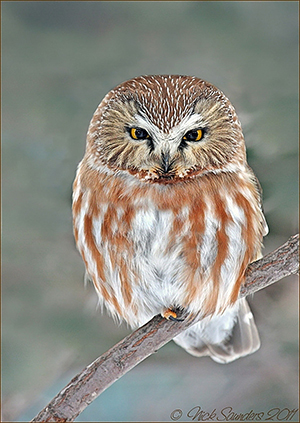 Besides their exceptional vision, owls also have extremely keen hearing. Their ear openings are directed forward and are much larger than those of other birds. The ears themselves are not visible because they are covered by feathers. The head tufts sported by some owls—the Great Horned Owl and Eastern and Western Screech-Owls, for example—are actually feathers that have nothing to do with the auditory process. Owls have asymmetrical ears—one with the central fold of the external ear directed downward, the other upward. This enables owls to locate most sounds with remarkable accuracy.
Besides their exceptional vision, owls also have extremely keen hearing. Their ear openings are directed forward and are much larger than those of other birds. The ears themselves are not visible because they are covered by feathers. The head tufts sported by some owls—the Great Horned Owl and Eastern and Western Screech-Owls, for example—are actually feathers that have nothing to do with the auditory process. Owls have asymmetrical ears—one with the central fold of the external ear directed downward, the other upward. This enables owls to locate most sounds with remarkable accuracy.
The combination of outstanding vision and hearing adds up to formidable detection equipment when owls hunt. The most amazing skill of owls is their ability to locate and actually catch prey by hearing alone. Laboratory experiments have proven that the Barn Owl can do this rather easily in complete darkness.
Silent Flight and Other Tools of the Trade
Owls are able to fly silently because their large, broad wings have serrated edges that mute the sound during flight. Other tools include strong feet and talons for grasping and killing prey, and a hooked beak for tearing the flesh of larger animals. Depending on the species, owls hunt and consume the following prey: insects, frogs, salamanders, fish, snakes, other birds, and mammals. The universal favorites, however, seem to be small rodents such as mice and voles.
Mice on the Menu
Owls swallow small prey animals like mice in one gulp—fur, bones, and all. The indigestible material is packed into a pellet and regurgitated a few hours after feeding. Pellets are usually gray or brown, oval or oblong, and may be found under regular owl roosts or nesting sites in trees, fields, or at the base of buildings. The bones in these pellets—sometimes entire mouse skulls—are good clues to the owl’s last meal. Biologists often analyze pellets in order to determine the dietary habits of owls and other raptors and the abundance of small mammals in a given area.
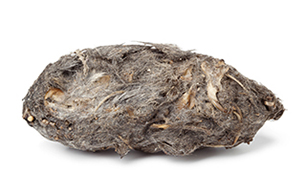
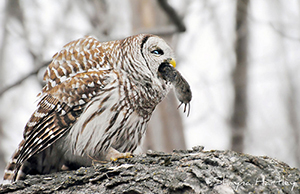
Owls play an important role in controlling populations of potential pest species such as mice, voles, rats, gophers, and shrews that damage crops and consume feed and thus owls are a great help to farmers. A Barn Owl, for example, eats one-and-a-half times its weight in prey in a single night and can kill 11,000 mice in its lifetime.
Owls Large and Small
Owl species vary in size, from the tiny Elf Owl (a little over 5 inches) to very large species, including the Great Horned Owl (22 inches long) and the Snowy Owl (23 inches).
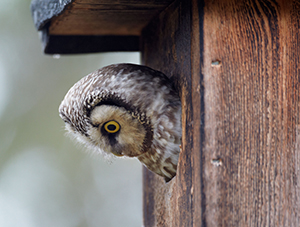
Nest Preferences
Owls generally do not construct their own nests, preferring to select a vacated nest built by crows, hawks, magpies, or other birds. To the Barn Owl, the rafters in old buildings are very compelling. Other species, like screech owls, select holes in old trees. Some species, such as the Snowy and Short-eared Owls, nest on the ground, while the Burrowing Owl nests in burrows underground, often an abandoned prairie dog or ground squirrel burrow.
The Fate of Owl Chicks
The round, white eggs are incubated as soon as they are laid. Since the first egg is produced days before the last (sometimes as much as two weeks), the chicks hatch at intervals and nestmates are of staggered ages. In years when prey is abundant there will be enough food for the entire brood, but when prey populations are low, the youngest and therefore weakest chicks cannot compete with the older, more robust siblings, and often starve or are eaten by their larger nestmates.
Photos: Jennifer MaHarry/Audubon Photography Awards; Deanna Beutler/Audubon Photography Awards; Nick Saunders/Great Backyard Bird Count; Shayna Hartley/Audubon Photography Awards; Shutterstock; Markus Varesvuo/NPL/Minden.




